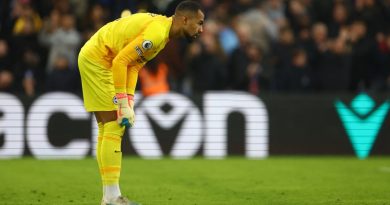Will a changing domestic transfer market impact on Brighton?
The January 2024 transfer window provided us with evidence that the Premier League’s Profit and Sustainability rules and the potential punishments which exist for breaking them are beginning to bite.
Not wanting to follow Everton and Nottingham Forest onto the Financial Fair Play charge list, English top flight clubs resisted splashing the cash.
If you exclude 2021 when transfer outlays plummeted amid Covid-19 uncertainty, 2024 had the lowest January window spent since 2012.

Just £96 million was paid by the 20 Premier League clubs, compared to around £700 million 12 months ago. The Premier League even lost its highest spending position to Ligue 1, with French teams paying out £163 million for new players.
The biggest spending English club were London underachievers Chelsea Crystal Palace, who signed £30 million worth of reinforcements.

Their first match once the transfer window slammed shut with their new-look, improved squad? A 4-1 defeat to Brighton at the Amex.
11 Premier League clubs did not register a single permanent transfer fee. Whilst that may come as a surprise, many did pay loan fees and some will have an obligation to buy in the summer.
Was this quiet transfer window a sign that the market is changing permanently? Or was it just a blip with clubs preferring to keep a war chest for the summer, when normal gluttony will be resumed?
And what does either scenario mean for a club like Brighton, who have arguably mastered the transfer market better than any other Premier League outfit?
Financial Fair Play – Good and bad
In terms of sustainability and hopefully equality, it was in many ways positive to see Profit and Sustainability Rules (PSR) reduce the astonishing figures spent in January 2023.
PSR requires clubs lose no more than £105 million across any three year period. It was brought in as an attempt to keep an even playing field and stop – for example – Newcastle United and their Saudi overlords spending £1 billion to buy instant success.
On the surface, this seems like a good idea. However, there are valid debates now being had on the unintended consequences of PSR – with three issues tipping the idea of Financial Fair Play into the bad category.
Trickle down economics
Clubs like Newcastle, Manchester City and Chelsea argue that if their owners are rich enough to afford spending money and absorb losses, why should they be prevented doing so?
How much the mega-rich clubs spend impacts on Brighton and other clubs further down the pyramid. In some cases, it can be seen as a lifeline which sustains the grassroots and genuinely transformative.
If Todd Boehly can no longer pay £115 million for Moises Caicedo, the Albion have less money to pass onto clubs like Reading or Southampton in exchange for young players like Caylan Vickers and Kamari Doyle.
The money paid for Caicedo by an American billionaire has made its way as far as Ecuador, where the £20 million Independiente Del Valle received via their sell on clause is set to build a football academy for young players in the country.
Boehly spends billions and children in Ecuador get a football facility they can use in the hope of becoming the next Caicedo. It is trickle down economics in footballing terms.
Book values
Then we have the distortions that PSR and player book value represents. Profit and loss on a player transfer is calculated from the difference between the transfer fee and the book value of a player.
Book value generally depreciates consistently across the length of a player’s contract, up to a maximum now of five years. If a club buys a player for £100 million, the club will show a loss of £20 million per year for the next five years.
The main distortion of book value comes when players are sold. Academy products have a book value of £0. If Chelsea therefore sold Connor Gallagher for £50 million, it would be recorded as £50 million pure profit towards PSR.
This explains why the Blues were rumoured to be looking at offloading their captain in January for what would have appeared a very low price. It also explains how Chelsea were able to sign Manchester City academy product Cole Palmer for just £40 million.
On the flip side, book value means clubs are loathe to sell big-money flops too early in their contract. 18 months into his Chelsea career and Marc Cucurella now has a book value of around £45 million from the very generous £62 million the Blues paid to take him to Stamford Bridge in the summer of 2022.
If Chelsea were to sell Cucurella now for £15 million, they would take a £30 million PSR loss from his book value. Instead, Cucurella is left to sit on the bench and waste his career until the fee the Blues might now receive for him becomes closer to book value.
PSR incentivises clubs to keep players they do not want and sell players they have developed for below market value. Nobody belives that is good thing.
PSR accounting periods
The account period PSR is calculated over also presents complications. One of the defences used by Nottingham Forest against their charge is they could have accepted £30 million from Spurs for Brennan Johnson before the accounting period closed at the end of June 2023 and not broken PSR.
Instead, they held off and secured £47 million for Johnson two months later. An entirely logical business decision and good negotiations which earned Forest an extra £17 million could now see them deducted points and relegated from the Premier League.
Forest equally contend that their transfer spend was necessary to establish themselves initially in the Premier League. They could even point to the success Brighton have had to justify the approach.
Tony Bloom spent heavily through the Albion’s first three seasons in the top flight. Once the Albion were established, they changed their transfer model to the current approach of signing young players with potential.
Brighton paid out £58 million, £78 million and £69 million between 2017 and 2020, bringing in only £16 million. Now the club is in a position where it can bank £400 million worth of player sales over three years, moving from a huge net loss to a net profit.
| Season | Transfers In | Transfers Out | Net Spend | Cumulative Net Spend |
| 2017-18 | £58m | £0m | £57m | £57m |
| 2018-19 | £78m | £13m | £65m | £122m |
| 2019-20 | £69m | £3m | £66m | £188m |
| 2020-21 | £21m | £20m | £2m | £190m |
| 2021-22 | £61m | £71m | -£10m | £180m |
| 2022-23 | £44m | £150m | -£106m | £74 |
| 2023-24 | £89m | £181m | -£91m | -£17m |
Quiet transfer window – a blip or a trend?
The million-pound question (or billion in Chelsea’s case) is whether or not the lack of spend in January is the start of a new PSR tend, or just a blip with cash likely to be splashed in the summer.
Sky Sports News argued for the latter in their transfer window review, although that may have been more wishful thinking than analysis given they barely had anything to report across the whole month.
The truth probably lies somewhere between the two. Spend is likely to pick up in the summer, but at the same time PSR will surely prevent it rising to Boehly-inflated levels.
How much transfer business happens in the summer may therefore depend largely on the amount of money coming into the Premier League from external sources – namely, the Saudi Pro League.
Saudi Pro Sportwashing League
If Saudi money comes flooding in as it did last summer, that will facilitate increased spending from the Premier League clubs who benefit from it.
Take Liverpool for example. If they were to accept a bid for £200 million for 31-year-old Mo Salah, they would have huge spending power even within PSR.
Sportswashing has the potential to be the biggest distorter of the summer market, with the added concern that said money is funnelled directly to clubs with Saudi interests.
Newcastle obviously, but the Saudi Public Investment Fund has also invested heavily in Chelsea owners Clearlake Capital.
An injection of Saudi money (£100 million for Cucurella, anyone?) could yet help Boehly get around the PSR problem he has created for himself.
All of this is conditional on the Saudi Pro League continuing on its crusade. Investment could in fact be scaled back as the huge sums spent so far have not exactly returned value for money.
Many highly publicised captures sought a return to Europe in January, with Jordan Henderson fleeing after less than six months to join Ajax.
The star signings have hardly captured public imagination, either. Cristiano Ronaldo, Sadio Mane, Neymar et all have seen the average Pro League attendance fall from 10,197 in 2022-23 to 8,345 in 20243-24, alongside no significant increase in TV coverage.
Sky Sports News
Finally, spare a thought for Sky Sports News. They spent the whole of January in usual over-the-top transfer mode, dedicating over five hours per day to coverage along with the entire final 24 hours before the window slammed shut.
With just 18 permanent transfers into Premier League clubs completed, this translated to around one signing per 10 hours of coverage.
Lewis Hamilton’s shock move from Mercedes to Ferrari did at least save deadline day itself, giving presenters something to talk about.
Otherwise, they had to find enough to waffle on about “major news” like Jesse Lingard going to South Korea and Mahmoud Dahoud swapping Brighton for Stuttgart.
A tough gig.
Peter Finn




